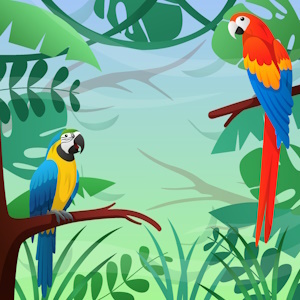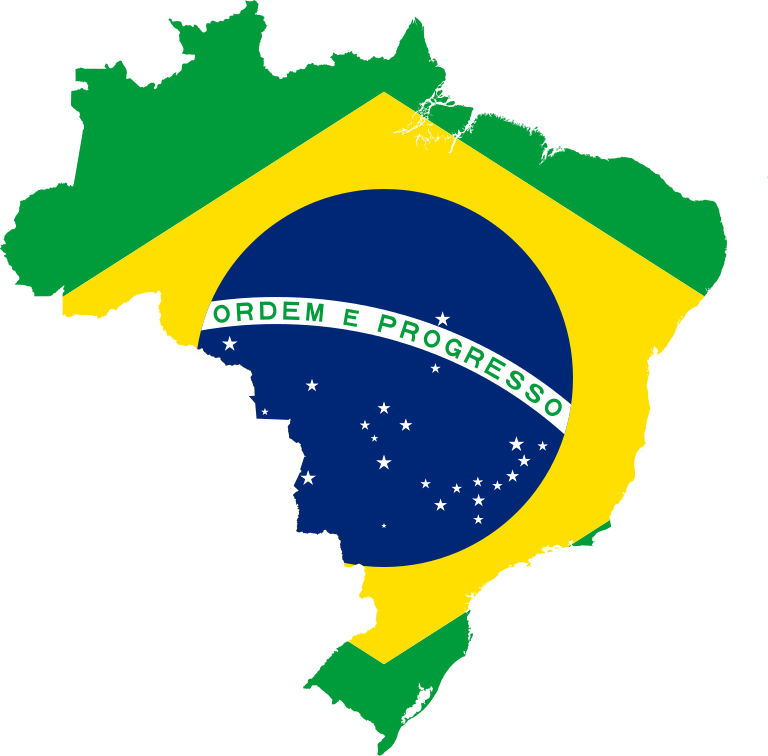Brazil's Amazon Jungle
Northern Brazil's Amazon Jungle
Facts to Know
The Amazon Rainforest is a large tropical forest in northern South America. It covers most of the drainage basin of the Amazon River and its tributaries in northern South America.
The majority of the Amazon rainforest is located in Brazil (around 60%). It covers 2,300,000 square miles (6,000,000 square km).
Explorers

Francisco de Orellana was a Spanish conquistador and the first European to travel the length of the Amazon river, in 1541-42. He reached the mouth of the river in August 1542 add he named the Amazon River.
Tropical Rainforest
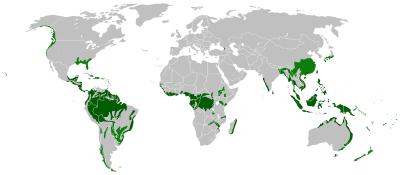
Tropical rainforest are located in the area between the Tropic of Capricorn and Tropic of Cancer, near the equator.
Why are rainforests found near the equator?
Tropical rainforest are located on 4 continents: Central and South America, Africa, and Asia,
Video
Climate & Land
Tropical weather; high temperatures and high rainfall.
The great interior of Brazil, much of which is covered by the rainforest basin of the Amazon, remains sparsely settled.
Layers Of Rainforests
There are four layers of rainforest. Each layer contains different flora (plants) and fauna (animals) unique to its environment. The difference between each layer is the amount of sunlight it receives.
Emergent Layer
Emergent is the top layer of the rainforest that is made of the tallest trees. This layer receives the most sunlight. It contains contains large large trees that reach heights of 100 to 250 feet (30 meters to 76 meters) above the forest floor.
The Kapok tree grows in this layer, it can grow up to 200 feet (60 m) high. The Brazil-nut tree is one of the most economically important plants of the Amazon and it grows in this layer. The Brazil-nut tree produces large fruit with 12 to 25 enclosed inside the large round fruit. The seeds are harvested for oil. It is still harvested from the wild and not plantations. When the large fruit falls to the ground it can reach speeds of 50 mph (80 km).

The trees are tall with small leaves coated in wax for protection against the heat from direct sunlight, rains and wind, and fluctuationg temperatures that are hot during the day and cold at night. Many of the tree branches are thin. The animals in this layer are usually the flying and gliding kinds. In this layer are eagles, hummingbirds, bats, pygmy gliders, monkeys, sloths, toucans, insects, and morpho (blue) butterflies
In the emergent layer flowers are not plentiful. In the lower areas of the emergent layer one flower thrives, orchids grow throughtout this layer.
Canopy Layer

The canopy layer is extremely dense. It is a maze of overlapping trees, leaves, branches, and vines. It rises over 100 feet (30 m) above the ground. During the day the canopy layer becomes the hottest part of the rainforest.
Scientist extimate that the canopy layer contains 60-90 percent of the living species in the rainforest. It is abundant in fruits and nuts. Making the canopy layer a rich habitat for plant and animal life. Some of the animals in this layer are animals capable of flying and glidering. There are Bornean Orangutans, snakes, treefrogs, insects, monkeys, lizards, and rodents.
Found abundantly in this layer are thick climbing vines that attach to trees and grow upwards toward the sunlight. Orchids, ferns, and air plants are called Epiphytes, it grows on trees but is not parasitic.
The canopy layer forms a roof over the two remaining layers. Only a small portion of sunlight to pass into the bottom layers of the rainforest.
Understory Layer
The Understory only gets 2 to 15% sunlight. This layer is humid and damp. Trees do not usually grwo past 12 feet (3.6 m) in this layer trees have thin trunks and grow large leaves to reach the sunlight. Vines grow up to reach the sunlight. Moss algae, and fungus grow on the trees. There are ferns, shrubs, and plants that flower (often brightly colored flowers).
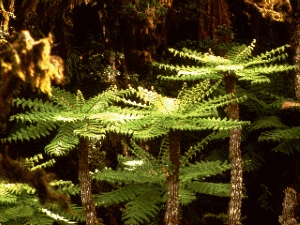
The Understory layer inclues a lot of insects, leafcutter ants, boa constrictors, jaguars, red-eyed tree frogs, leopards, bees, beetles, snakes, monkeys, birds, geckos, bats, and butterflies.
Forest Floor
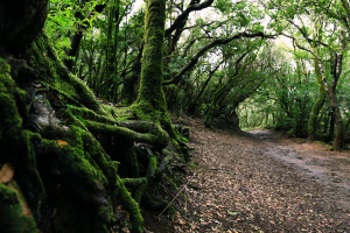
The Forest floor layer is very dark. It is the darkest and most humid layer of a tropical rainforest. In this layer there is only 2% light and 100% humidity, almost no plants grow in this layer. Mushrooms and fungi trive in the warm and moist conditions in this layer.
This layer is where decomposition takes place. Leaves, branches, fruits, twigs and seeds fall onto the Forest floor layer. In this dark and moist layer decompostion happens quickly. A leaf that would take one year to decompose will dissappear in 6 weeks on the Forest floor layer. Giant anteaters, earthworms, termites, and cockroaches live in this layer.
Many of the largest rainforest animals are found on the forest floor layer and are a mix of both carnivores and herbivores. The jaguar in Central and South America, elephants in Asia, the tapir in Southeast Asia, Central and South America, and tigers in Asia.
Strata What can you find in each layer of the Rainforest?
What Are the Layers of the Rainforest and What Species Inhabit Each? handout.Animals
The dense Amazonian jungle is home to more than thirty-five hundred species of birds, tens of thousands of different kinds of insects, eighty percent of all species of life can be found in this jungle, and it is speculated that tens of thousands of life forms in the jungle may still be unidentified.
PBS Featured Wildlife: Life on Land.
Frogs, Red-Eyed Tree—Suction disks for fingers and toes.
Army Ants will eat whatever it can outrun.
Over two thousand species of fresh-water fish are believed to live in Amazonian waters.
The pirarucu is one of the largest freshwater fish in the world and can weigh up to 400 pounds.
Video
Plants
Thousands of different varieties of plants live in the rainforest.
Things to Do
Resources for Teachers at Rainforest Alliance (pre-k-grade 8)
Play Amazon Explorer!
Explore the wilds of the Amazon jungle.
Video
See Also



